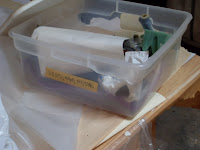 That's a bin in my Mom's studio, and the title of this blog post.
That's a bin in my Mom's studio, and the title of this blog post.I'm just back from New Orleans and New Iberia. It's kind of a strange feeling to find that you're working on the same art-problems as your mother. Maybe it's only natural, given that she raised me, but it's still (mostly) uncharted territory for both of us, and seemed a weird coincidence. Maybe we're tapping into the Zeitgeist.
Mom is working on wallpaper, in elaborately symbolic patterns of appropriated pictures. The templates that I've seen look something like Max Ernst and, well, wallpaper. But sharpened, barbed. I mean they come to a point.
She begins the patterns with a sense of what she wants to represent (which I suppose I do, too, though not quite in the same way that she does), and then proceeds to exhaust that design theme through association. In so associating, she comes upon new strains of imagery that she can then exploit and elaborate. It's really pretty amazing. I'll post a few samples next week, and maybe try to get her to talk about some of them, too.
Her idea is to paper a room (maybe more than one) at KKProjects with one of the wallpaper designs. We went to the site to do some measurements, and I got a look at the installations that are up now, I think from Prospect 1.


Three (very) run-down houses in the Bywater, New Orleans, owned by the eponymous KK and used as exhibition spaces. The one that Mom is going to be papering is half Kudzu, half house.

The site is actually very beautiful, especially on the day that we visited.
And we finally got to see Mom's mural, in the CBD:

It is much bigger than it looks in the picture. If you're in New Orleans in the next year or so, it's up at the corner of Poydras and Carondelet, on the back of the Le Pavillon hotel.
That is part of the ceiling of the Sistine Chapel, superimposed on a photo of the kid who stole a bus to get residents of New Orleans out of the city after Katrina. It's part of a series of such images called "Broken Rainbow."
It is proof positive that simple (binary) juxtaposition can be very powerful. Think again of Max Ernst, and the first great Surrealist collages, still some of the most successful Surrealist pieces.

The lesson of Surrealism was that the artistic faculty rests in association as well as in creation. The Surrealists were perhaps not the first to say this, maybe not even the most successful example of it, but their example has certainly had a profound effect on the 20th and the (beginning of the) 21st century.
